The persistent and constant push driven by bike manufacturers to normalise the use of electric mountain bikes on our trails should mean it comes as no surprise that smaller, more niche companies are trying their hardest to keep up with the big players.
- Best electric bike 2019: 10 e-bikes you should be considering
- Merida eONE-SIXTY 10K first ride review
We’ve seen Orange release not one but two brand new electric mountain bikes, Pivot has established itself as a market leader with the Shuttle, and even brands such as Intense, who’s built its reputation on race-ready bikes, is in the electric bike business now.
There’s also a lot of debate about electric bikes; where they sit in the market and whether there’s even a place for them on the trails. Obviously, everyone has their own opinion on this, and that’s something we’re all entitled to.
I’ve heard a lot of the arguments both for and against the electric mountain bike — the most compelling pro eMTB case, in my humble opinion at least, touts them as a replacement for the gravity-orientated rider's penchant to rely on vans, chairlifts, tractors or trucks as their uplift method.
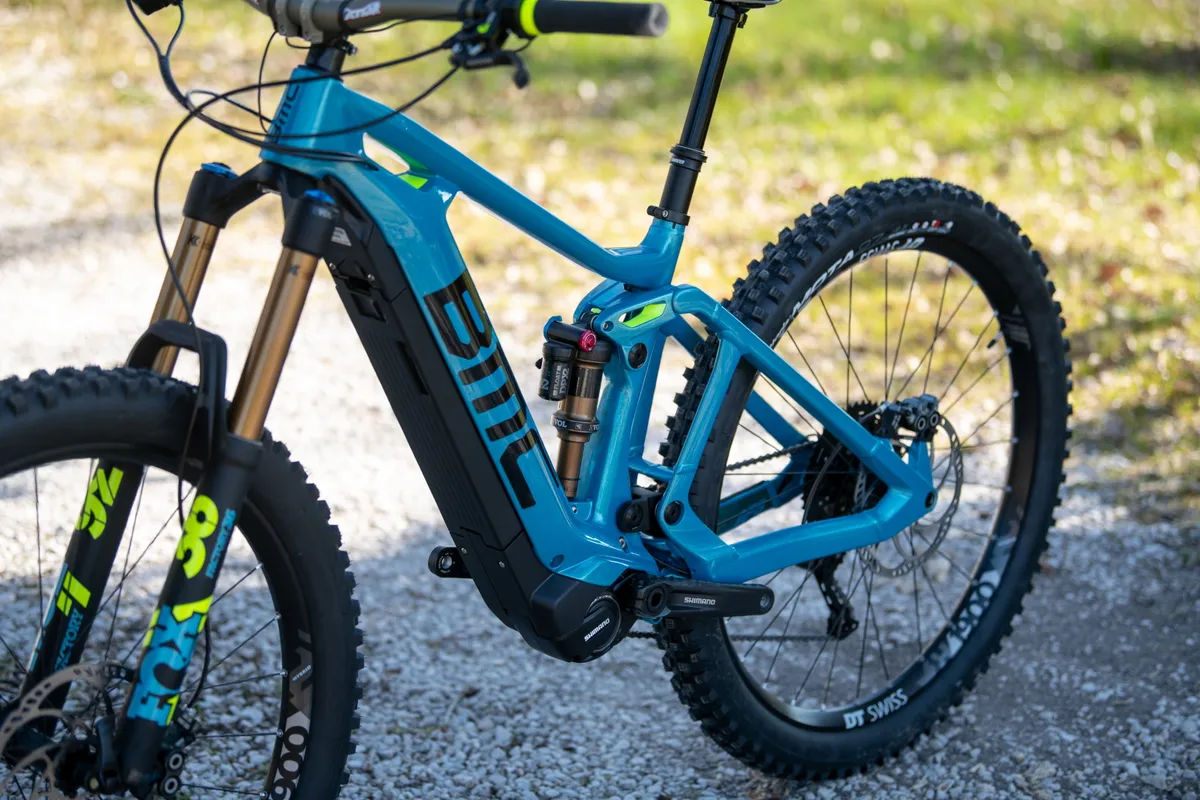
Electric mountain bikes as uplift or shuttle transport
This is where the Trailfox AMP SX comfortably steps in. It’s sold as a bike that’ll help enduro and aggressive riders push their boundaries in both the bikepark or out on the open trails. Our tech writer Seb Stott tested the smaller, tamer version of the AMP SX last year — to find out what he thought read his first ride review.
With loads of travel, fairly relaxed geometry (more on the details later) and that all-important electric motor, it’s clear that the Trailfox AMP SX is well positioned to provide a helping hand on the tough climbs normally associated with accessing the best trails, essentially replacing the need for a dedicated and rather archaic uplift solution.
BMC Trailfox AMP SX frame details
The bike’s looks are striking, particularly the oversized down tube that can swallow up a Shmano STEPS E-8020 500Wh battery with easy.
The bike’s down tube construction is called Twin Hollow-core Technology — this means the down tube has two hollow sections that create its strength and should make it stiff enough to deal with the rigours of hardcore electric mountain bike riding while being big enough to conceal the battery.
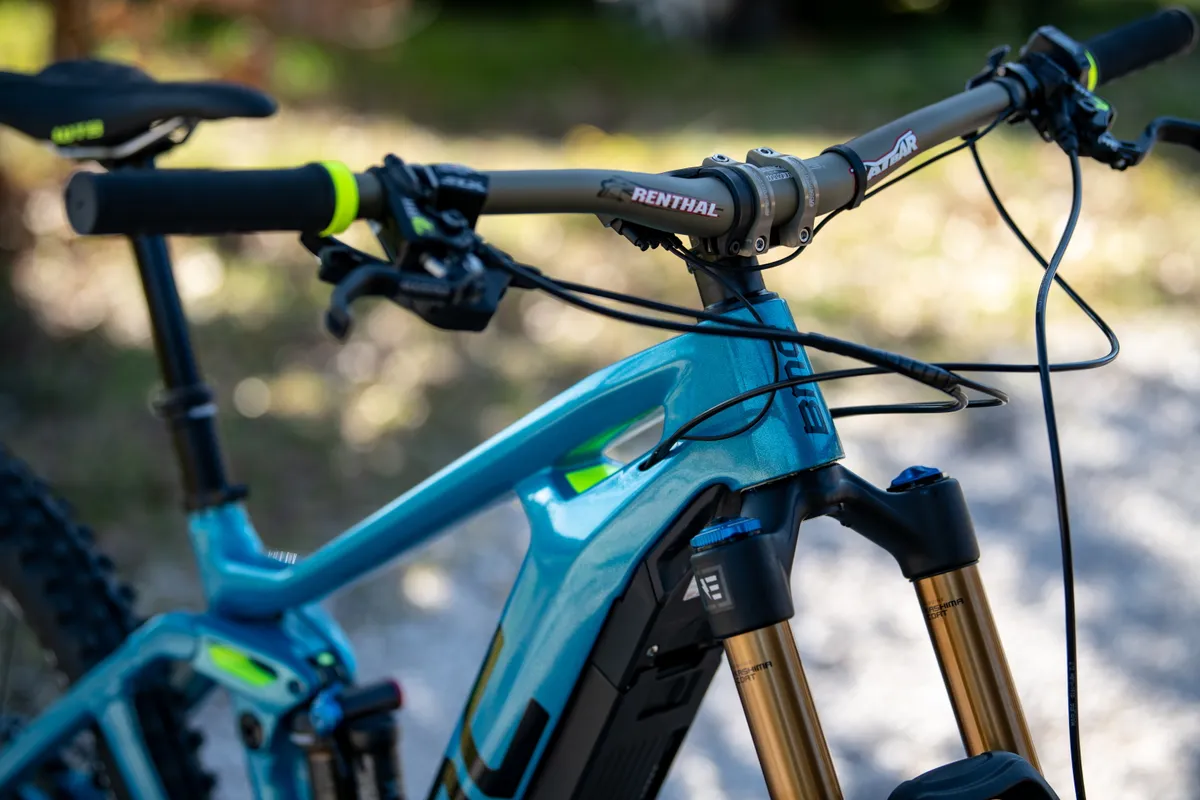
Bolted to the underside of the down tube is a Shimano STEPS MTB E-8000 250w, 70Nm output motor that’s protected by a cover which also smooths out the bike’s lines.
The speed sensor is integrated into the bike’s rear triangle close to the dropouts with an internally-routed cable. The corresponding speed sensor magnet is mounted to the disc brake rotor bolts instead of the spokes.
A sag indicator is located on the driveside chainstay, close to the pivot. The rocker link has a marker on it that, as it rotates, indicates the correct level of sag with corresponding scale on the rear triangle.
The frame has an in-built chainstay protector to help reduce noise generated by chain slap but doesn’t have an in-built seatstay protector. Both gear and brake cables are internally routed along the full length of the frame, entering at the head tube and exiting at their respective destinations.
The frame’s front triangle is made from carbon fibre, while the pivot-free rear triangle is constructed using an Al-13 triple-butted aluminium to help manage the torsional forces exerted by electric mountain bikes.
BMC Trailfox AMP SX geometry
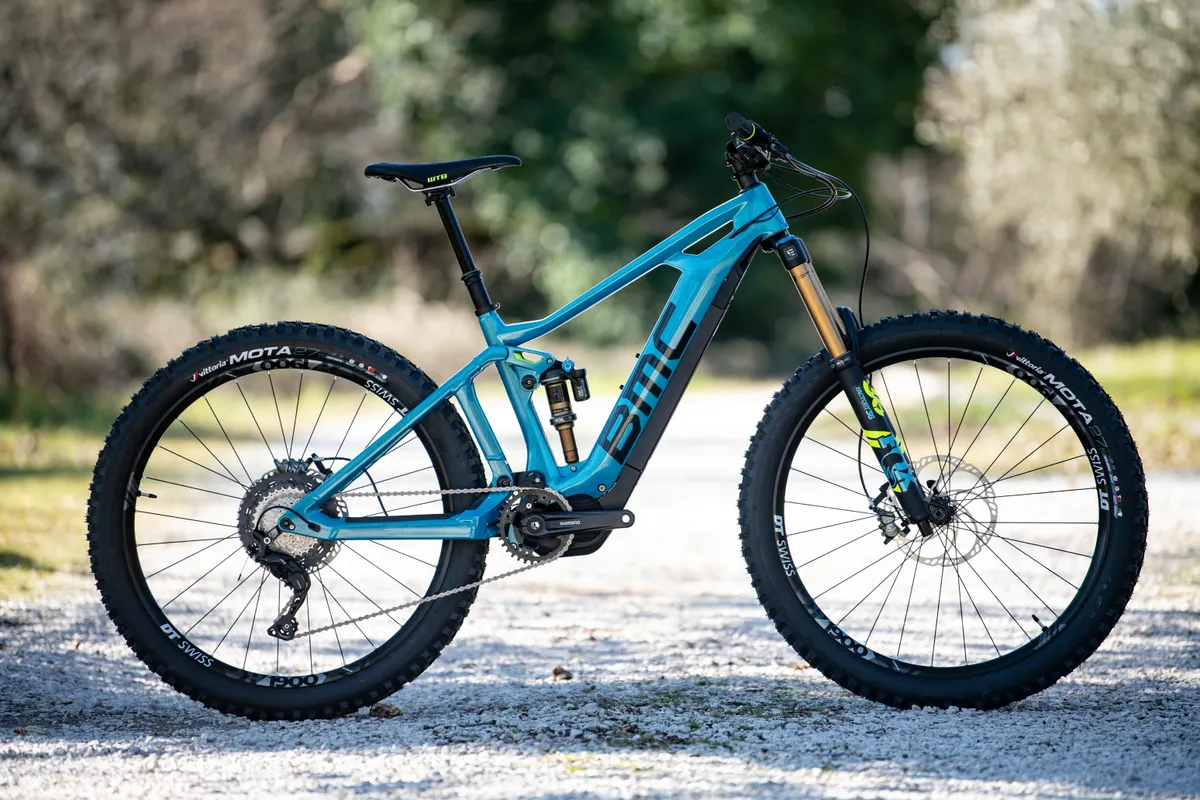
For the size large we tested, headline geometry figures include a 1,238mm wheelbase that’s coupled with a 445mm chainstay, a 645mm long top tube a 469mm reach, a 74-degree seat tube angle and a 65-degree head angle.
While those figures aren’t pushing the limits of bike geometry, they’re a welcome lean towards longer, slacker and more aggressive numbers that should translate to a stable and more controlled ride.
I think it’s fair to call out BMC’s size guide. It claims that the medium bike is suitable for people between 170cm and 185cm tall, but at 178cm I felt perfectly comfortable on the size large. And I don’t feel like I’d able to recommend a size large to anyone taller than 185cm. It feels like BMC could do with an extra-large model in its line-up for people over the 185cm mark.
- Seat angle: 74 degrees
- Head angle: 65 degrees
- Chainstay: 445mm / 17.51in
- Seat tube: 480mm / 18.89in
- Top tube: 645mm / 25.39in
- Head tube: 118mm / 4.64in
- Bottom bracket drop: 17mm / 0.66in
- Wheelbase: 1,238mm / 48.74in
- Stack: 620mm / 24.40in
- Reach: 469mm / 18.46in
- All geometry figures for size large
BMC Trailfox AMP SX suspension
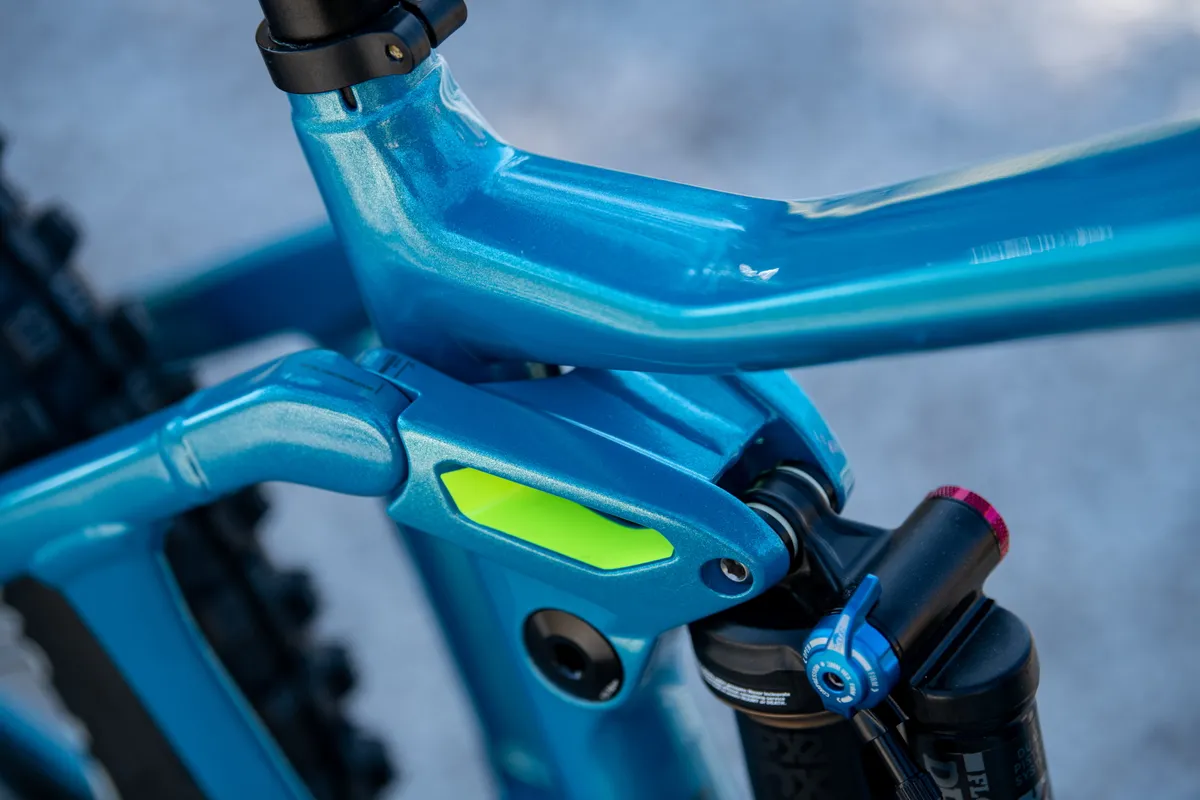
At the heart of the Trailfox AMP SX is its Advanced Pivot System (APS, for short), which connects the front and rear triangles in a system that’s similar to Giant’s Maestro, the DW-link and most other virtual pivot point bikes.
The APS system, BMC claims, can be tuned to work for a very wide variety of applications from XC racer through to gnarly enduro electric mountain biker, thanks to changes of the pivot location and rocker link lengths
On the Trailfox AMP SX, the two short links move in a concentric motion, the top one compressing the rear shock, the lower simply allowing this movement to be controlled.
The system provides 150mm of rear wheel travel, which is damped by a Fox Float DPX2 Factory EVOL shock that has rebound, open mode compression adjustment and three compression positions: firm, medium and open to help control pedal bob and unwanted movement.
Fox claims the DPX2 is a mix of both the X2’s hardcore focussed performance and the DPS, its lighter weight XC and trail-orientated shock.
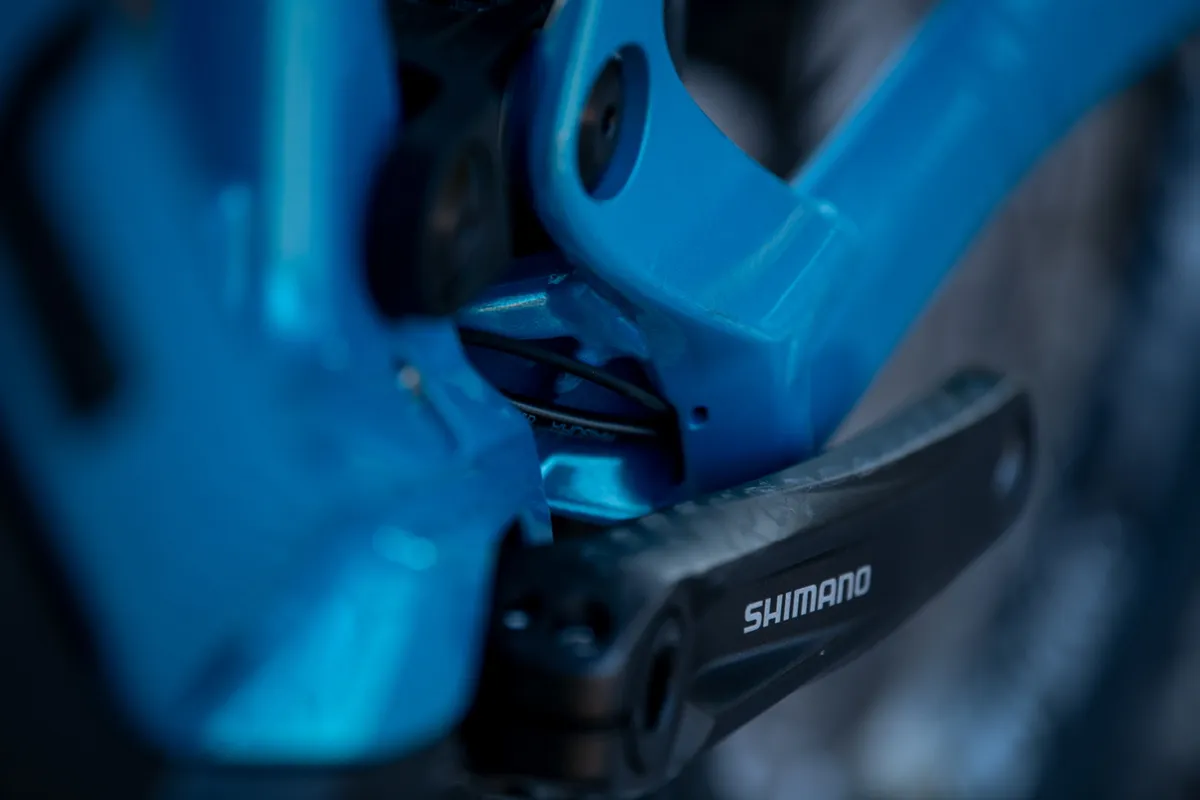
BMC Trailfox AMP SX specifications and components
Armed to the hilt with big, burly and top performing kit, BMC wasn’t messing about when it specced the Trailfox AMP SX.
Standout performances include the fantastic Fox Float 36 Factory FIT4-damped forks with 170mm of travel and a rather impressive set of Vittoria Mota DH 27.5in x 2.5in wide tyres that are wrapped around 35mm internal width DT Swiss H1900 rims.
There’s a full Renthal cockpit and the bike has Magura MT7 four-piston brakes with 200mm rotors front and rear.
- Price: £ Not available / $7,999 / AU$ Not available / €7,999
- Frame: Twin Hollowcore carbon construction front triangle, triple-butted aluminium rear triangle 12 x 148mm axle
- Drive unit: Shimano STEPS MTB E-8000 250W, 70Nm with a 34-tooth chainring
- Battery: Shimano STEPS MTB E-8020 500Wh integrated
- Fork: Fox Float 36 Factory FIT4 E-MTB (170mm travel) 15 x 110mm axle
- Shock: Fox Float DPX2 Factory EVOL (150mm travel)
- Cassette: Shimano SLX 11-46t
- Mech: Shimano XT Shadow Plus
- Shifter: Shimano SLX
- Chain: Shimano CN-HG601
- Brakes: Magura MT7 (200mm rotor front and rear)
- Bar: Renthal Fatbar 800mm wide, 20mm rise, 31.8mm clamp
- Stem: Renthal Apex 40mm long
- Seatpost: Fox Transfer Performance Elite 150mm drop
- Saddle: WTB Silverado Comp
- Hubs: DT Swiss H1900
- Rims: DT Swiss H1900 35
- Tyres: Vittoria Mota DH 27.5in x 2.5in
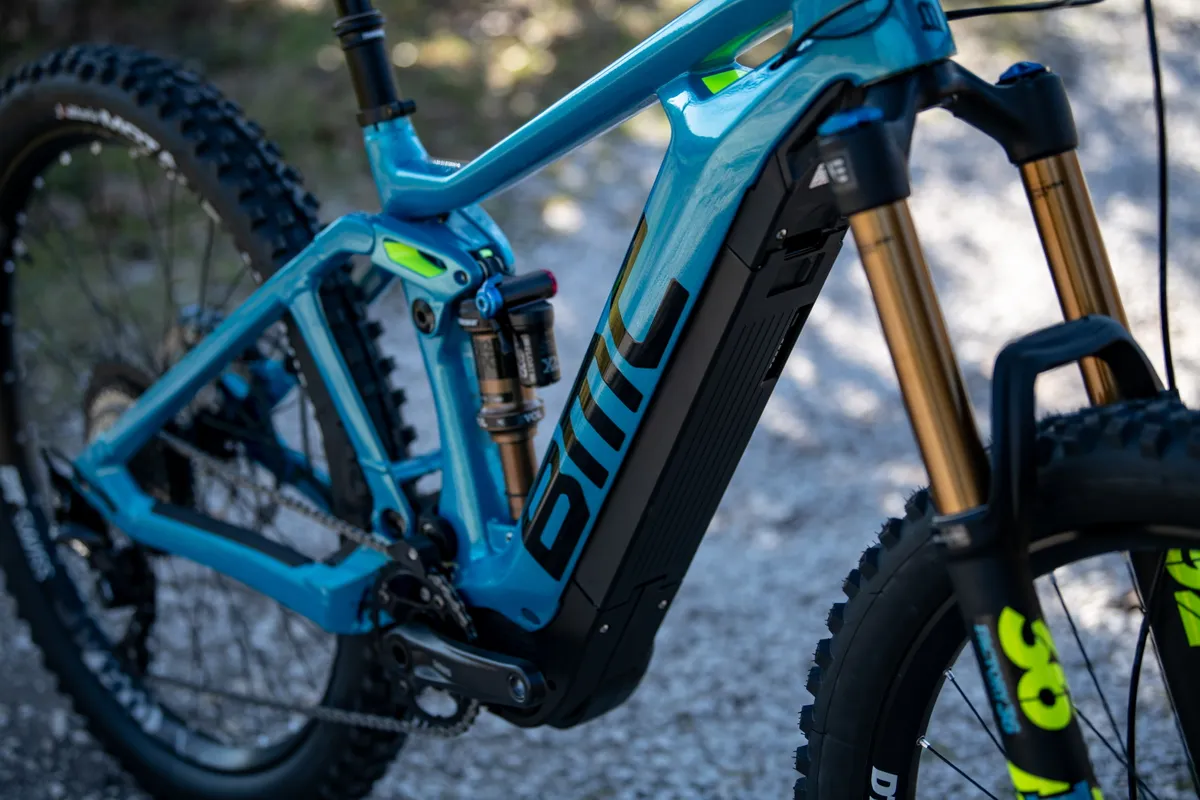
BMC Trailfox AMP SX ride impressions
Like when you jump on any electric mountain bike, the Trailfox AMP SX’s power assistance is impressive becayse it counters the bike’s hefty weight with absolute ease and conviction.
Turn the motor assistance off and you’ll see exactly what I mean here — on climbs and flat sections, the bike feels lardy and slow until you flick that magic switch to the ‘on’ setting.
BMC Trailfox AMP SX climbing performance

Pointing the bike skyward is an impressive affair, then. The bike’s large size is comfortable and roomy enough for someone who’s around 6 foot or 180cm tall — the 645mm top tube provides ample wiggle room and space to shift your weight front and back to help conquer techy bits of trail.
The 469mm reach number provides plenty of space when you’re climbing in a standing position, but the frequency of that happening on an electric mountain bike is quite low. The additional room is still welcome, though, and all of the geometry figures work in unison rather than alone to create a comfortable ascender.
The Shimano STEPS motor provides plenty of assistance even in Eco mode
With that in mind, the 1,238mm wheelbase helps when you’re pointing directly up a steep climb. The extra length means that the bike is less likely to ‘wheelie’ as you put the power down and helps to keep things stable at slower speeds.
Coupled with the 445mm chainstays, which although fairly short for an electric mountain bike are still long for a mountain bike in general, there’s enough length behind you to further counter the penchant for the front wheel to lift when you select Turbo mode on particularly steep climbs.
Although I did have to angle the seat’s nose down and push it as far forward in the rails as the seatpost clamp allowed. This indicates that a steeper seat tube angle would help to make the bike climb better.
Couple a lengthy and stable chassis with the insanely grippy Vittoria Mota 2.5in wide tyres, and climbing is a doddle. The tyres bite into the ground and grip with a decisively sharp feeling of forward motion — thanks in part to their motocross-inspired blocky tread pattern and width. They measure up much wider than 2.5in and are closer to 2.75in.
The Shimano STEPS motor provides plenty of assistance even in Eco mode but don’t expect it to compensate for poor gear choice or whisk you to the top of the hills without a single drop of sweat on your brow — the motor seems to thrive on higher cadence pedalling and I found that 90rpm suited the Eco mode best.
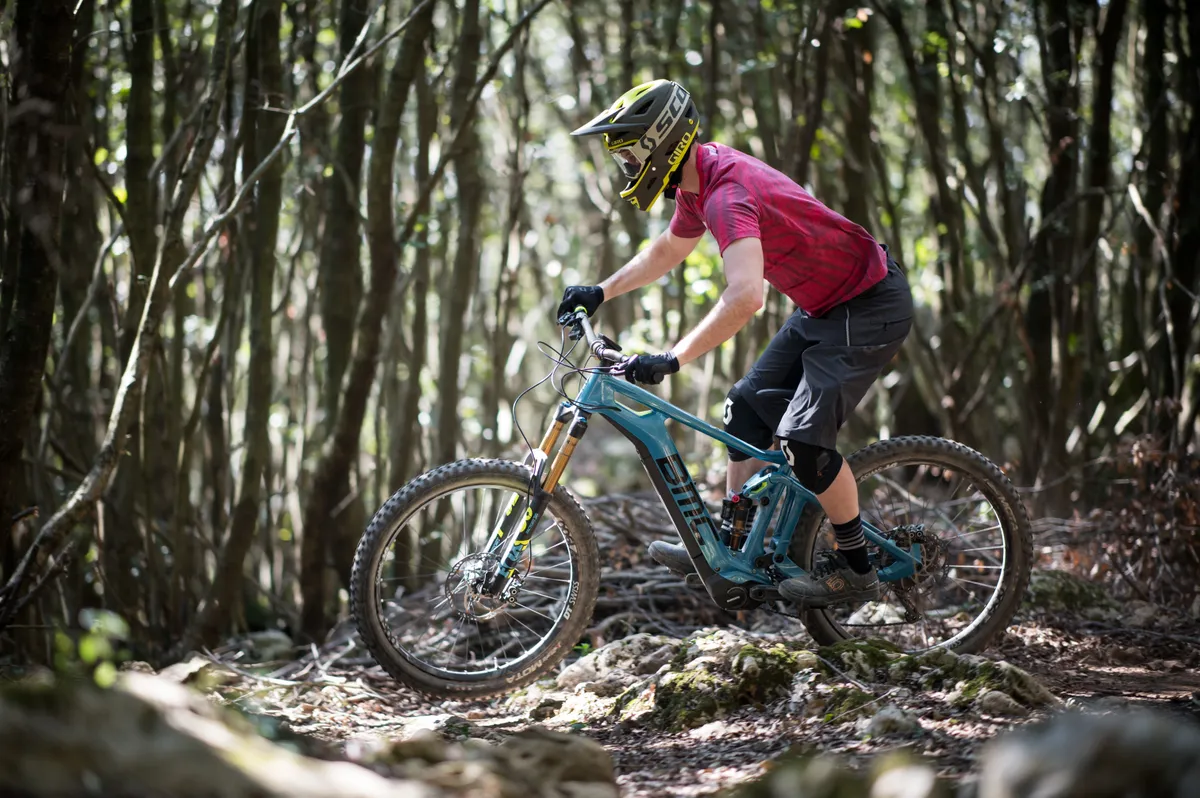
Despite the chassis’ best efforts to tame unwanted front wheel lift, if you bosh the Shimano system into Boost mode and mash the pedals the front wheel does become skittishly light.
Further to that, the power cut-off in some scenarios is quite abrupt. For example, I noticed that if you’re riding a flat or uphill trail with stumps, rock or root steps, or obstacles that require you to lift the front and back ends of the bike, the motor cuts out too quickly. To perform this sort of manoeuvre you need to come off the pedals, but as soon as you stop pedalling the power assist cuts out, which means you’ll come to an abrupt halt just as you reach the crest of the obstacle you’re trying to mount.
In the bike’s defence, this is a technique-dependent example, but the added weight of the motor and battery make it much harder than it would be on a traditional bike and it would be nice to see the bike’s power not stop the instant you finish pedalling when you’re climbing or manoeuvring the bike on a technical trail.
To reduce unwanted power assist when you’re descending this could be implemented with an additional mode called ‘technical climb’ or similar.
Although the most dominating part of an electric mountain bike is the motor and how it delivers its power, it’s worth a shout out to Shimano’s XT and SLX combo 11-speed drivetrain for its reliability and accurate shifting, even when you’re expecting it to do its job under less than ideal on-power conditions.
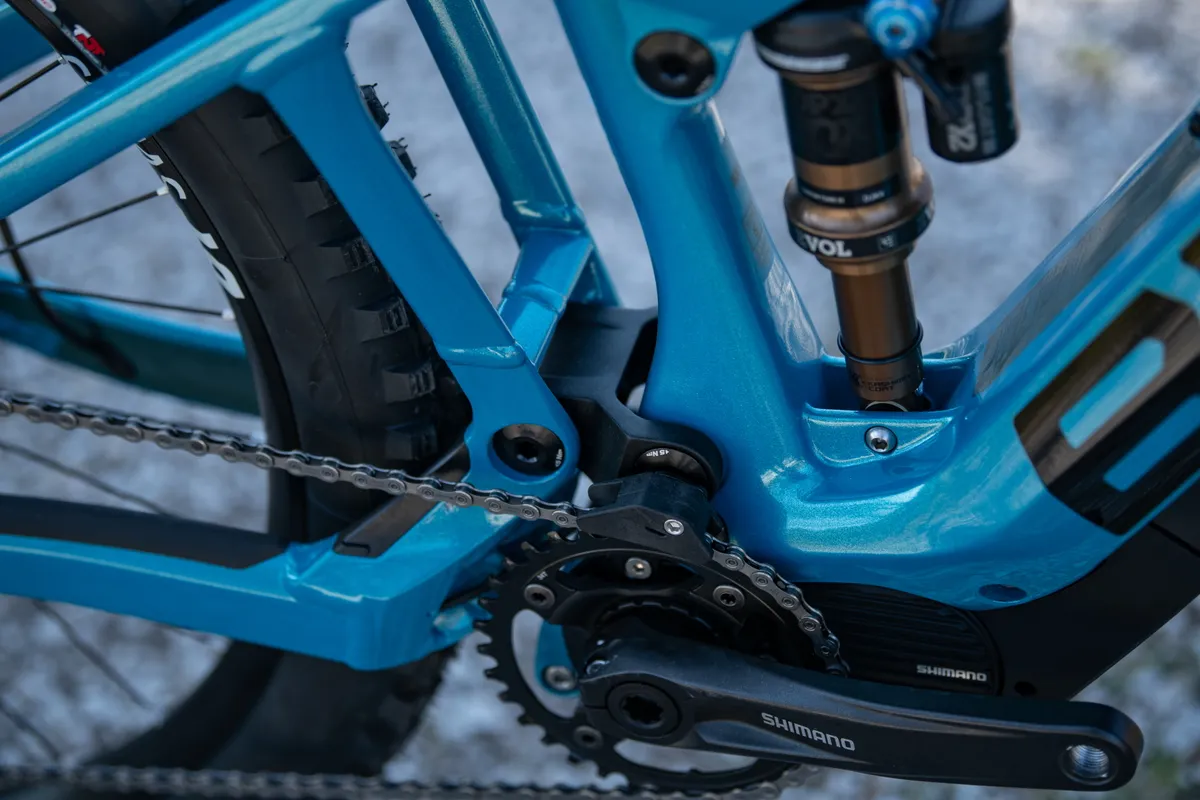
The bar-mounted mode change and display scroll buttons, when positioned as close to the grips as possible, do cause an issue with the Fox Transfer dropper post lever.
To get the dropper post actuator close enough to use without having to move your hand, its lever fouls the Shimano remote when it has been pushed enough to actuate the post.
This irritated me — I didn’t want to move the Shimano remote further away from the grips thus reducing my ability to change modes on the fly and in the same vein I was reluctant to move the dropper post’s lever inboard on the bars making it harder to actuate.
A solution to this problem could be to change the side of the Shimano remote to the gear shifter, change the dropper post out for another brand’s offering, checking first that it doesn’t foul the Shimano remote, or Shimano could remove some of the unnecessary bulk, of which there is quite a bit, on its display and mode changing remote.
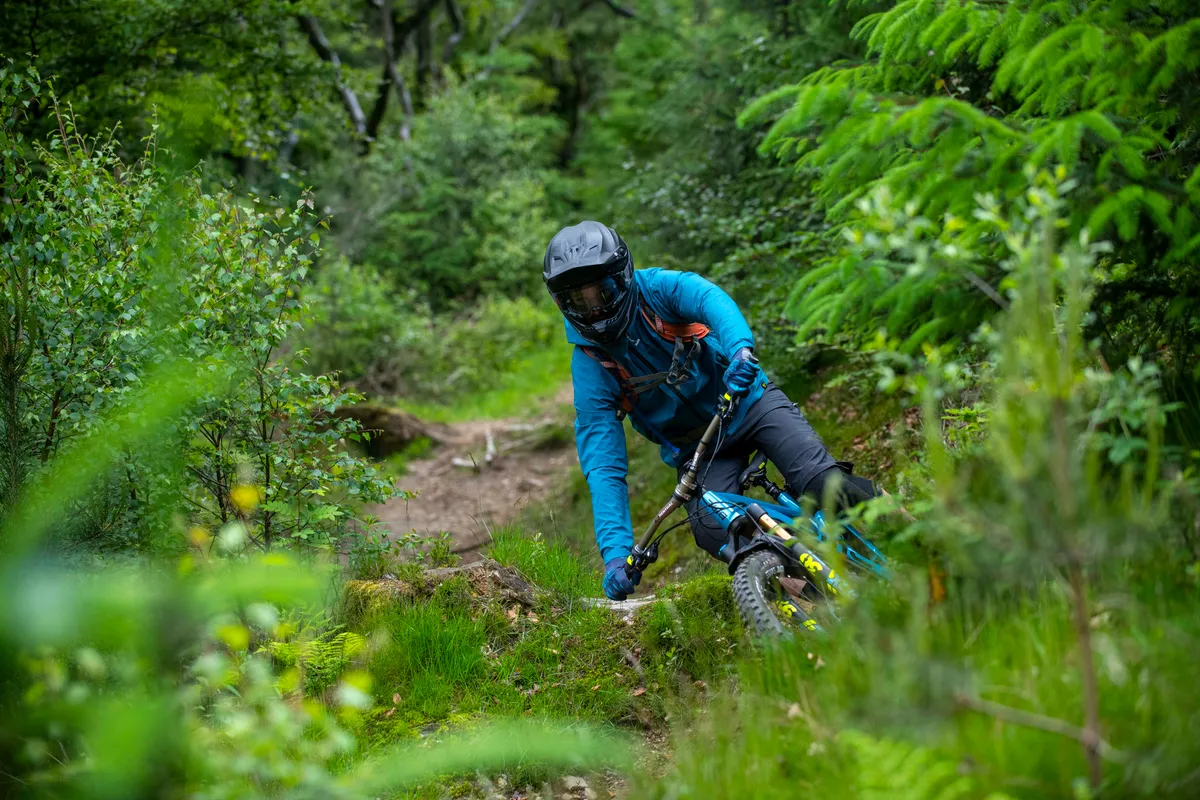
The suspension remains fantastically active under power and does a great job of smoothing out bumps on flat trails and climbs, but with the motor to assist you, the three-position compression lever feels a tad redundant.
BMC Trailfox AMP SX descending performance
Turn the bike back down the trail and the level of grip, suspension suppleness and general control is staggering.
The sprung to unsprung mass ratio is high — there’s more weight held up by the bike’s suspension than isn’t. This means the bike tracks the ground exceptionally well, absorbing the smallest bumps, creating an incredibly smooth ride.
This ability to absorb the smaller hits means the bike’s wheels are in contact with the ground more than if they weren’t tracking the bumps as well. Couple this with the exceptionally grippy tyres, and the bike corners and brakes more akin to a Formula One car with fresh tyres than an MTB on dirt.
I did burp the tyres though — both front and rear— when riding particularly aggressively. Elevating the pressure from 22psi (front) and 24psi (rear) to 24psi (front) and 26psi (rear) reduced the problem, but this amount of pressure does begin to negate the usefulness of plus size tyres. A solution to this problem could be a CushCore or Procore system fitted from the factory or an even thicker tyre casing.
The extra weight also helps the bike maintain speed through rough bits of trail and even when I regularly exceeded the motor assist speed on flatter trails, the bike didn’t turn into an unwelcome lead weight, instead holding speed with poise and control.
The wheelbase, reach, chainstay and head angle figures complement the bike’s ability to go fast, giving a roomy, comfortable and stable platform from which it’s possible to make deliberate movements and weight shifts that change the bike’s direction in a predictable way.
If you get out of shape or get something wrong, then you aren’t punished by a bike that changes trajectory on a whim.
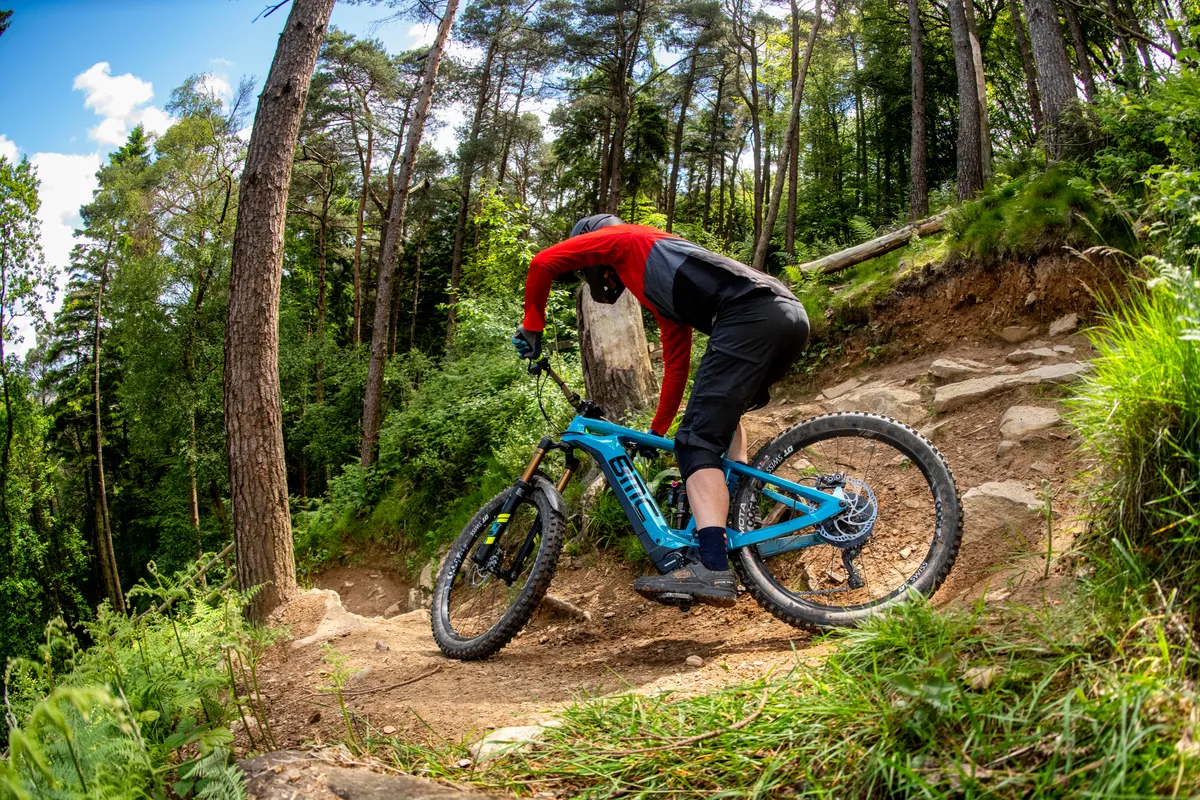
Best suited to a pick and commit style, if you’re riding with conviction the BMC helps you maintain lines and speed where others will falter. The overall package is surprisingly forgiving, even over exceptionally rough terrain, and I didn’t notice any unwanted fore and aft pivoting caused by bigger steps and hits usually amplified by weight, which can be present on electric mountain bikes with less sorted geometry.
The Magura brakes proved their worth too — they offer exceptional modulation and superb levels of power
The Fox 36 FIT4 damper is an excellent performer and more than an equal match for the Trailfox’s weight and levels of speed that can be attained. I was a little sceptical about the rear shock’s ability to cope with the type of riding the bike is designed to do, expecting it to get overwhelmed or bottom out excessively. But, to my surprise, it has proven to be a very capable shock, almost certainly helped out by the frame’s inherent suspension traits and the sprung to unsprung weight ratio.
Over jumps the bike is quite poppy, although this doesn’t mean it feels light. The pop originates from the suspension rather than any inherent in-built characteristic in the frame’s construction. If you push into the lip of a take-off, the bike will jump in a predictable and fun way, but don’t expect to be whipping like Brendan Fairclough in too much of a hurry — it’s still a heavy behemoth of a machine.
The Magura brakes proved their worth too — they offer exceptional modulation and superb levels of power, not once overheating or showing any signs of wavering performance. They are quite hard to set up, though, and I struggled to get them to not hum or vibrate when pedalling around. This didn’t affect their performance.
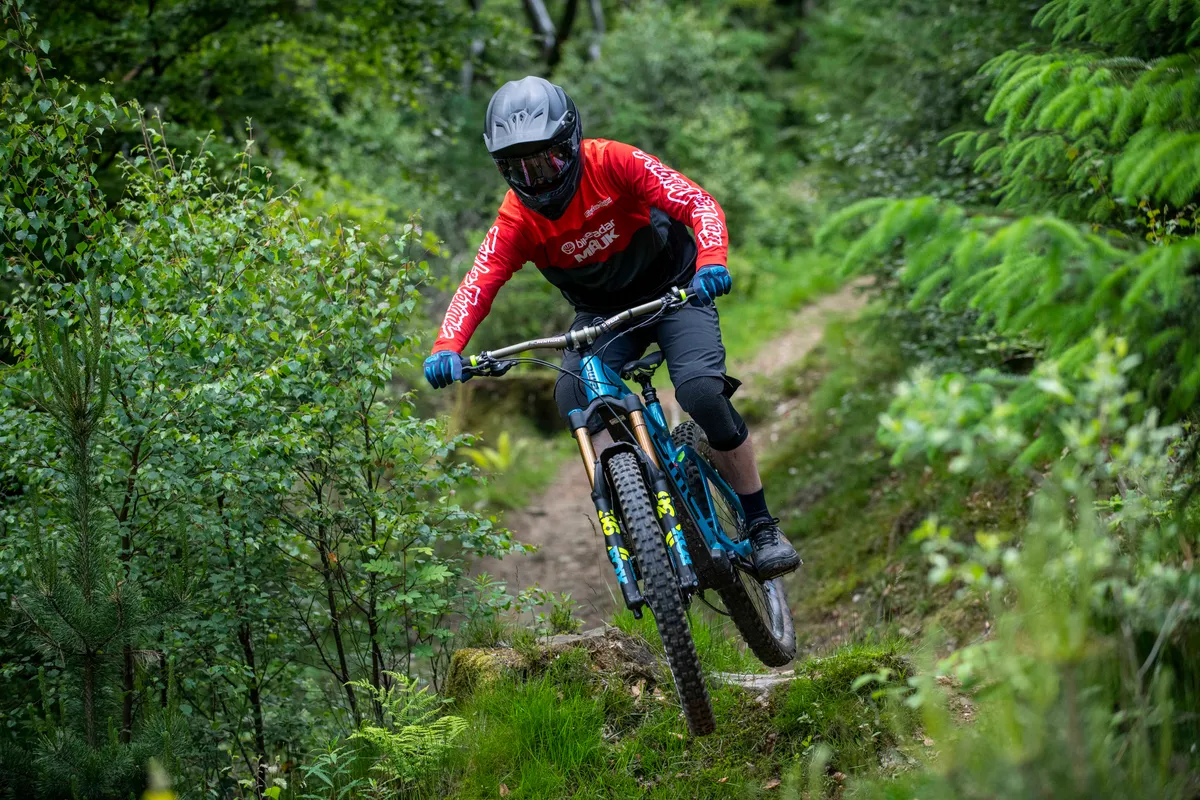
BMC Trailfox AMP SX Shimano STEPS battery life
In Eco mode I managed to eke out a 33.73km ride with 1,700 meters of climbing over 2 hours and 10 minutes. During that time I rode 12 descents of two-ish minute long downhill tracks.
That’s considerably more riding in considerably less time than I’d ever have managed on a normal bike and I had good fun doing it.
You’ll reduce the battery’s range in Trail and Boost modes and if you’re riding up steep climbs the electric juice won’t last as long. Eco mode offered more than enough assistance for me.
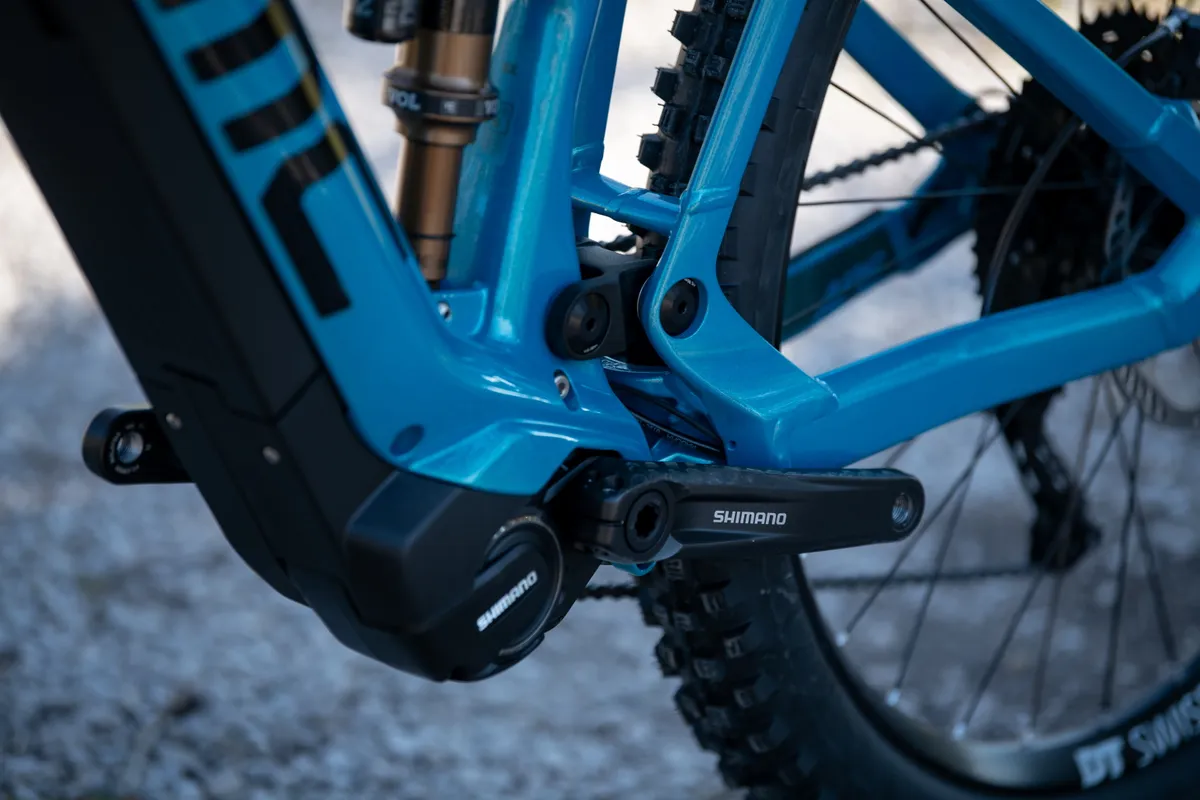
BMC Trailfox AMP SX bottom line
It's a speed-focussed bike that creates as much of a thrill on the climbs and flat sections as it does on the downhills. With a bike as capable as this, the only thing that limits you is the battery’s range and your appetite for riding.
Will it replace the uplift vehicle? In my opinion, it’s not far off and is considerably more eco-friendly than a fossil-fuelled van, car or truck or electric powered chair lift.
